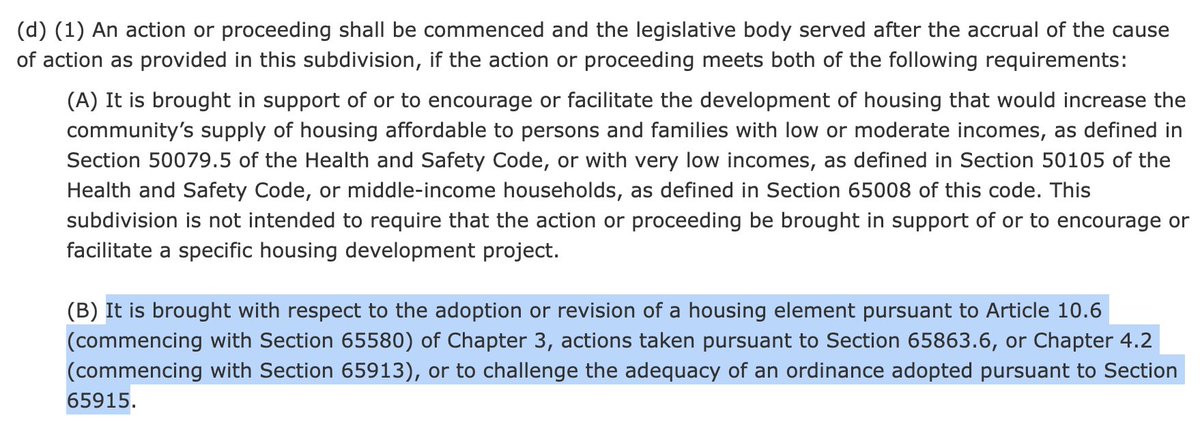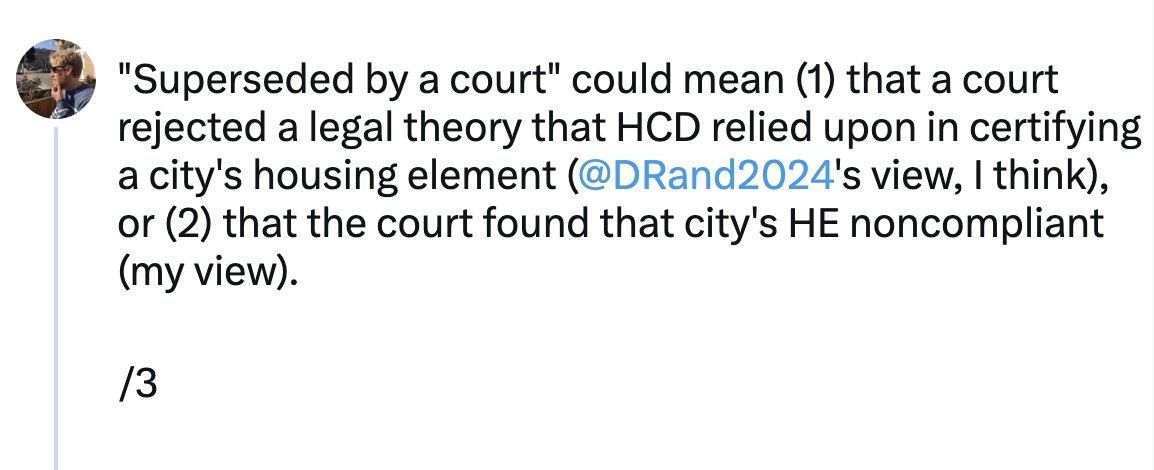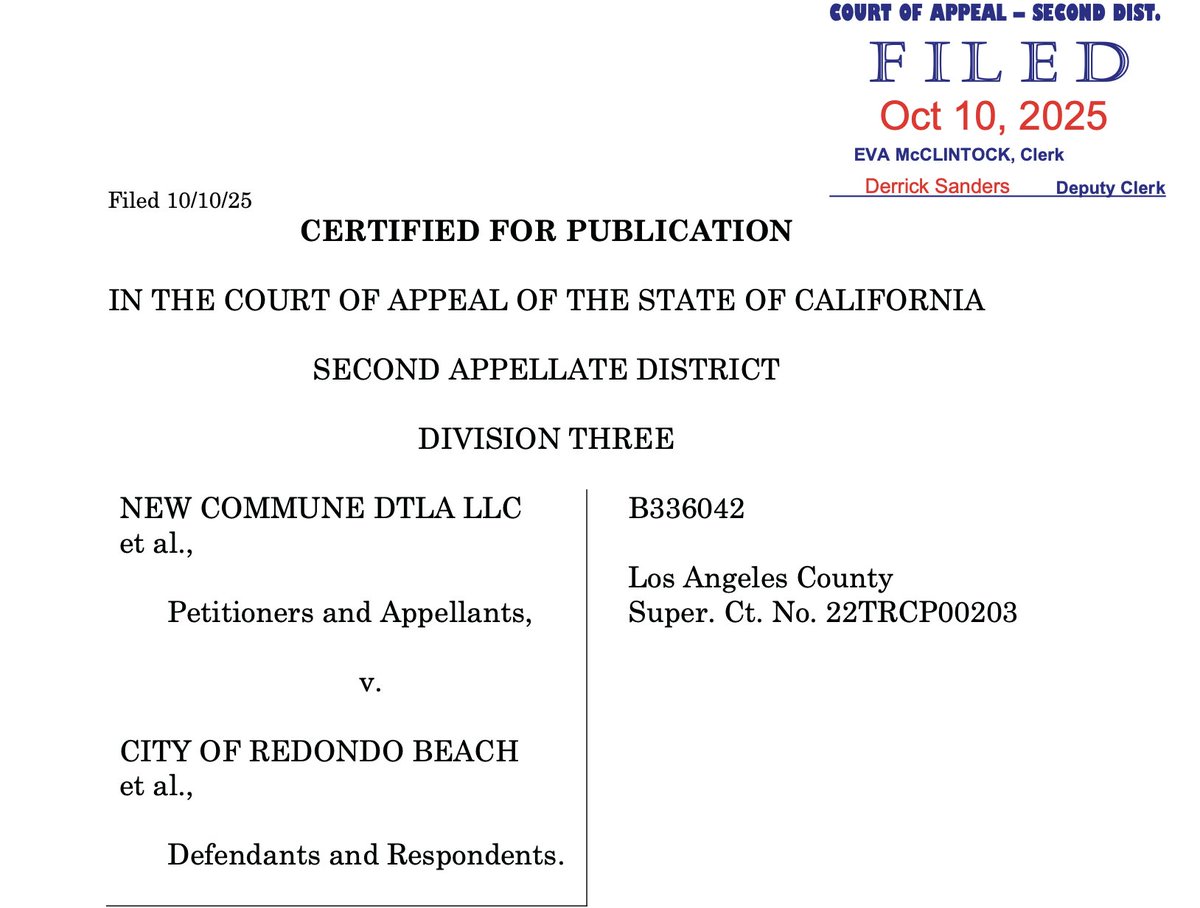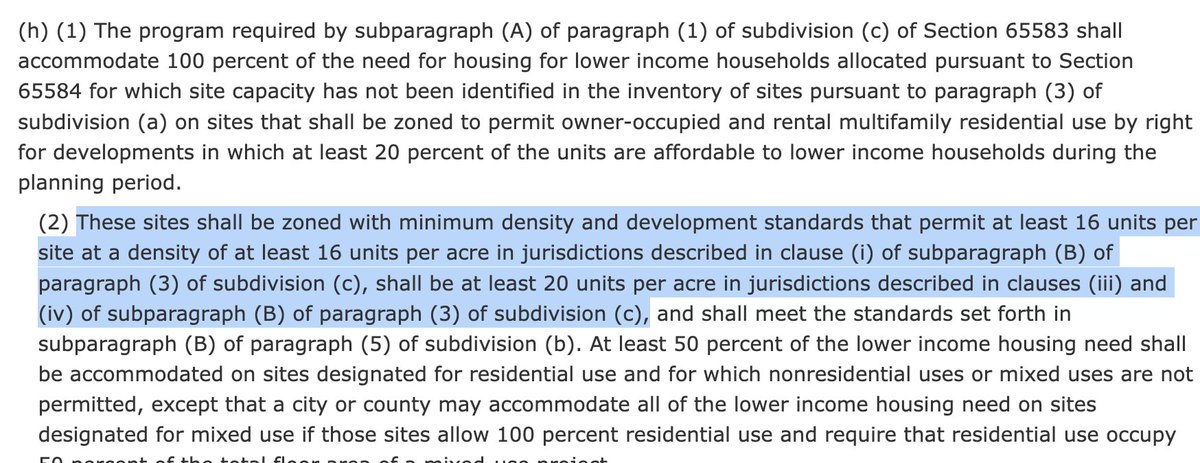A 🧵on rolling the dice ⤵️ on mid-cycle Builder's Remedy, in light of New Commune v. Redondo Beach.
I'll sketch the argument for the builder, the counterargument, and why I think @California_HCD, @AGRobBonta, and the courts should probably accept the counterargument.
1/25
I'll sketch the argument for the builder, the counterargument, and why I think @California_HCD, @AGRobBonta, and the courts should probably accept the counterargument.
1/25
https://twitter.com/DRand2024/status/1976848601671463196
See screenshots for relevant statutory text.
Key idea: A city found to be in compliance by HCD is compliant as a matter of law until HCD has revoked its finding or the finding has been "superseded by ... a decision of a court of competent jurisdiction."
/2

Key idea: A city found to be in compliance by HCD is compliant as a matter of law until HCD has revoked its finding or the finding has been "superseded by ... a decision of a court of competent jurisdiction."
/2


"Superseded by a court" could mean (1) that a court rejected a legal theory that HCD relied upon in certifying a city's housing element (@DRand2024's view, I think), or (2) that the court found that city's HE or rezoning noncompliant (my view).
/3
/3
Although GC 65589.55(a) ties Builder's Remedy to the most recent official compliance determination as of date of BR project application (in keeping w/ my view), the statute's use of phrase "only if" (rather than "if and only if") makes Rand's view textually plausible too.
/4
/4

That is, while there are only two ways for a city to become substantially compliant for BR purposes (determination by HCD or a court), there may be other ways for a city to lose compliance (e.g., court superseding a legal interp. that HCD relied on in finding compliance).
/5
/5
So why do I think my interpretation is probably better than Rand's? Two reasons.
Point #1: GC 65009 declares a state policy "to provide certainty for property owners *and* local gov'ts," via short, firm statutes of limitations for land-use matters.
/6
Point #1: GC 65009 declares a state policy "to provide certainty for property owners *and* local gov'ts," via short, firm statutes of limitations for land-use matters.
/6

In most circumstances, challenges to general plan or zoning change must be brought within 90 days.
There's are somewhat longer SOLs for challenges to housing elements and certain other matters implicating affordable housing.
/7
There's are somewhat longer SOLs for challenges to housing elements and certain other matters implicating affordable housing.
/7

To challenge a housing element that HCD has approved, plaintiff must give notice to city w/in 270 days of HCD's approval, and city then has 60 days to cure the alleged violation before plaintiff may file lawsuit.
/8
/8

Does this 270-day rule cover HE rezonings too?
Doubtful. HE rezonings aren't listed in the subd. (d) exceptions to the usual the 90-day statute of limitations.
/9
Doubtful. HE rezonings aren't listed in the subd. (d) exceptions to the usual the 90-day statute of limitations.
/9

If HE rezoning challenges qualify for a longer SOL (not the 90-day rule), it's probably via GC 65009(d)'s reference to GC 65863.6, which concerns Livermore challenges but which, if stretched, may cover HE rezonings too (b/c HE rezonings are also about regional housing need).
/10

/10


In sum, the Leg has crafted a framework that establishes very tight SOLs for most land-use matters, with a narrow exception for certain affordable housing matters. To invoke the exception, plaintiff must first give city 60 days to cure alleged violation.
/11
/11
A holding that a builder can acquire vested rights to a BR project by filing a prelim application *whenever* they think a court or HCD *should* revoke HCD's prior determination of compliance (e.g., b/c of a new judicial interpretation of HE law) would blow up this framework.
/12
/12
It would mean there's never a firm time limit on challenges to housing elements & implementing actions, contrary to declared policy of "certainty for property owners & cities."
And it would deprive cities of the "60-day period to cure" w.r.t. affordable-housing matters.
/13
And it would deprive cities of the "60-day period to cure" w.r.t. affordable-housing matters.
/13
A developer by filing a BR project application would be able to relitigate city's housing element compliance at any time, and city would have no opportunity to cure the alleged violation & stave off the builder's remedy.
/14
/14
Point #2: To the extent that the law is unclear, I think, on policy grounds, that it should be interpreted in a manner that lets cities rely on HCD's determinations of compliance.
/15
/15
The HE law is ridiculously complicated, and the requirements for lower-income sites are hard for anyone to parse.
HCD could have issued safe harbors for cities but largely it has not.
The consequences for noncompliance (builder's remedy) are clear and serious.
/16
HCD could have issued safe harbors for cities but largely it has not.
The consequences for noncompliance (builder's remedy) are clear and serious.
/16
Under these circumstances, the only way for courts to provide a measure of certainty for even good-faith cities is to let cities rely on HCD's finding of compliance, i.e., treat that finding as "good" for BR purposes until revoked by HCD or rejected by a court.
/17
/17
Consider the alternative, in which "superseded by a court" means "there's a new Court of Appeal decision that undermines an interpretation of law that HCD relied upon in finding the HE compliant."
/18
/18

New Commune v. Redondo Beach held, inter alia, that a supermarket site didn't count as a low-income RHNA site b/c of lease details & city's failure to show that supermarket was likely to be shuttered.
Another site, for which city conducted feasibility study, passed muster.
/19
Another site, for which city conducted feasibility study, passed muster.
/19
As I pointed out, this holding renders lots of HE site analyses legally vulnerable.
But it's hardly clear whether any given HE still passes muster. That depends on whether suspect sites were "buffer" or necessary, on p(dev) adjustment if any, etc.
/20
But it's hardly clear whether any given HE still passes muster. That depends on whether suspect sites were "buffer" or necessary, on p(dev) adjustment if any, etc.
/20
https://x.com/CSElmendorf/status/1976841890411733238
Moreover, it's unclear whether New Commune's holding on the Von's supermarket site superseded an interpretation of law that HCD had generally relied upon, or whether HCD just misapplied its own guidelines vis-a-vis this Redondo Beach site.
/21
/21
Down "route 1" lie so many hard questions for courts and so much uncertainty for cities. I just don't think it's worth it, or fair to the cities that have made a good faith effort to comply with the law.
/22
/22

And it's not like "route 2" lets cities off the hook! HCD can initiate decertification proceedings under GC 65585(i) at any time, and private plaintiffs can challenge rezonings if they do so w/in the 90-day or possibly the 180-day period of GC 65009.
/23
/23
So down "route 2," the Redondo Beach decision could still be applied this cycle. But only in citiies where HCD decides to initiate decertification, or, via private plaintiffs, in cities that rezoned recently (last 90-180 days) or in the future.
/24
/24
Last comment: this 🧵reflects my preliminary thinking, which is s/t change. @DRand2024 or others may know of relevant caselaw or leg history that I've missed. Corrections & challenges are welcome as always!
/end
/end
@threadreaderapp unroll
• • •
Missing some Tweet in this thread? You can try to
force a refresh












